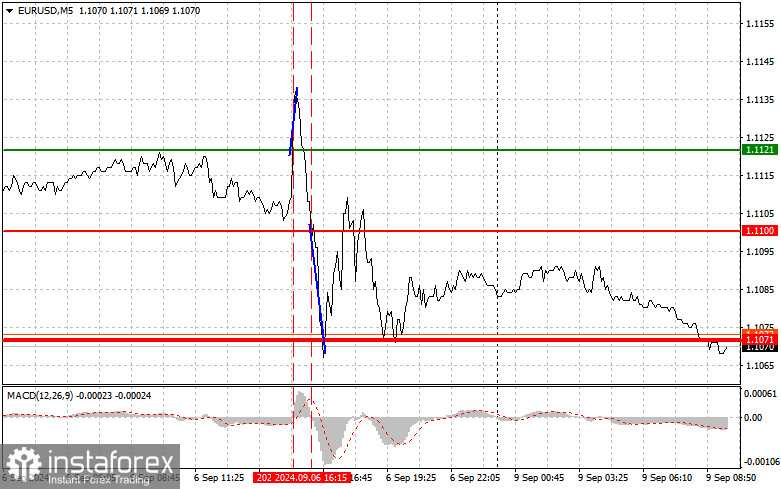Trade Analysis and Tips for Trading the Euro
The price test of 1.1121 occurred when the MACD indicator started moving up from the zero mark, confirming the correct entry point for buying the euro. However, despite the U.S. data, the pair did not actively rise. Closer to the middle of the U.S. session, the price test at 1.1100 occurred when the MACD began moving down from the zero mark, confirming the entry point for selling the euro. As a result, the pair dropped to the target level of 1.1071, allowing for a gain of about 30 pips. Data on Germany's industrial production, the external trade balance, and the Eurozone's GDP were ignored, while the drop in the U.S. unemployment rate to 4.2%—the first in the last five months—was met with active purchases of the dollar and a fall in the euro. Today, we expect the Eurozone investor confidence indicator from Sentix and nothing more, so we can hardly count on a significant upward movement of the euro. For the intraday strategy, I will rely more on implementing scenarios No. 1 and 2.

Buy Signal
Scenario No 1: Today, you can buy the euro when the price reaches the area of 1.1093, plotted by the green line on the chart, with the goal of rising to 1.1134. At 1.1134, I plan to exit the market and sell the euro in the opposite direction, counting on a movement of 30-35 pips from the entry point. Expecting the euro to rise today in the first half of the day will only be feasible with favorable Eurozone data. Important: Before buying, ensure the MACD indicator is above the zero mark and starting to rise from it.
Scenario No 2: I am also going to buy the euro today in case of two consecutive tests of 1.1057 when the MACD indicator is in the oversold area. This will limit the pair's downward potential and lead to a reverse market upturn. Growth to the opposite levels of 1.1093 and 1.1134 can be expected.
Sell Signal
Scenario No 1: I plan to sell the euro after reaching the level of 1.1057, plotted by the red line on the chart. The target will be the level of 1.1018, where I will exit the market and buy immediately in the opposite direction (expecting a movement of 20-25 pips in the opposite direction from the level). Pressure on EUR/USD will return today if there is a failed attempt at correction in the first half of the day. Important: Before selling, make sure that the MACD indicator is below the zero mark and is just starting to decline from it.
Scenario No 2: I am also going to sell the euro today in case of two consecutive price tests of 1.1093 when the MACD indicator is in the overbought area. This will limit the pair's upward potential and lead to a reverse market downturn. A decrease to the opposite levels of 1.1057 and 1.1018 can be expected.

What's on the Chart:
Thin green line: the entry price at which you can buy the trading instrument.
Thick green line: the estimated price at which you can set Take Profit or manually close positions, as further growth above this level is unlikely.
Thin red line: the entry price at which you can sell the trading instrument.
Thick red line: an estimated price at which you can place Take Profit or manually close positions, as further decline below this level is unlikely.
MACD indicator: when entering the market, it is essential to be guided by overbought and oversold zones.
Important: Novice traders in the forex market need to be very careful when making decisions about entering the market. It is best to stay out of the market before important fundamental reports are released to avoid getting caught in sharp price fluctuations. If you decide to trade during news releases, always place stop orders to minimize losses. You must set stop orders to avoid losing your entire deposit, especially if you don't use money management and trade in large volumes.
Remember, a clear trading plan, like the one I've outlined, is essential for successful trading. Making impulsive decisions based on the current market situation is a losing strategy for novice intraday traders.
 English
English 
 Русский
Русский Bahasa Indonesia
Bahasa Indonesia Bahasa Malay
Bahasa Malay ไทย
ไทย Español
Español Deutsch
Deutsch Български
Български Français
Français Tiếng Việt
Tiếng Việt 中文
中文 বাংলা
বাংলা हिन्दी
हिन्दी Čeština
Čeština Українська
Українська Română
Română

